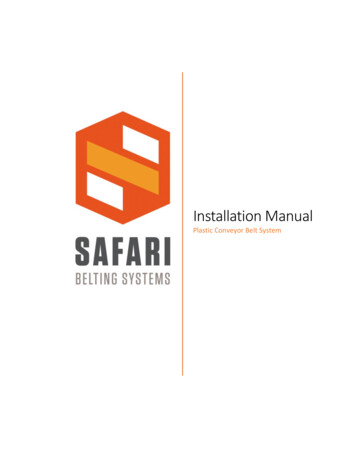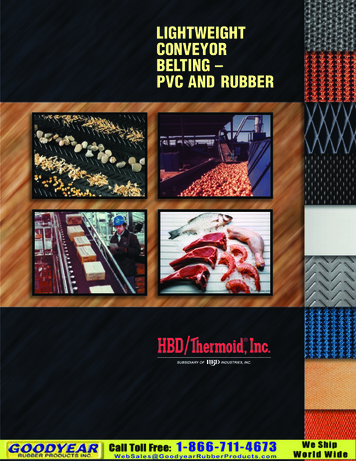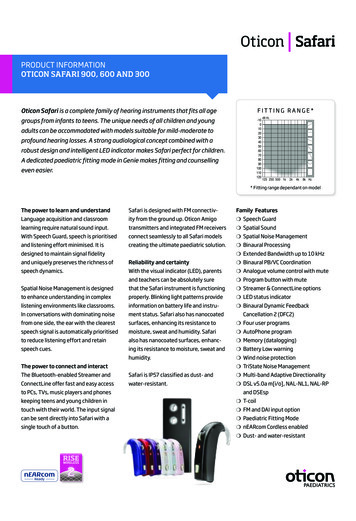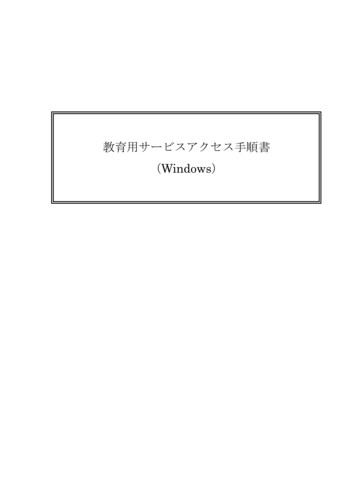
Transcription
Installation ManualPlastic Conveyor Belt System
Installation ManualContentsInstallation Instructions . 2Table #1 . 2Conveyor Belt Under 6 Feet . 3Conveyor Belt Over 6 Feet . 3Conveyor with Full Return Slider Bed . 4Center Drive Conveyor . 4Incline Conveyor . 5Wear-Strip and Belt Support Structure. 5Returnways . 5Parallel Style Wear-Strip Pattern . 6Wedge Style Wear-Strip Pattern. 6Belt Tracking. 7Shaft Squareness. 7Sprocket Installation . 8Figure #1 . 8Figure #2 . 9Contact Information. 9Updated 06/2017Safari Belting Systems, Inc.1
Installation ManualInstallation ke sure power is off to system. Be sure to lock‐out and/or tag‐out.Install correct number of sprockets on drive and idle shaft. (See Table #1)Align timing marks on sprockets if applicable.Secure only the center sprocket using retainer rings or set collars on the drive and idle shaft.Allow remaining sprockets to “float”.Install shafts, making sure they are square to the conveyor.Check to make sure that the wear‐strip/carry‐bed is clean, in good condition and free of anysnag points.Install and connect each belt section using the pins provided.Using a soldering iron, partially melt the pin connecting each section one (1) link from the edge;this will serve to retain the pin in the belt. To remove the pin, simply place a punch on the pinend and strike with a hammer.Once the entire belt is installed, make sure the belt and sprocket are engaged properly.Adjust the centenary sag. There should be 1” to 4” of sag between return rollers or shoes placed36” to 48” apart (See Table #1).Make sure nothing is obstructing the operation of the conveyor belt.Either by hand, or at low RPM, operate the conveyor, checking the performance of the conveyorsystem.Adjust the conveyor system as needed.Normal break‐in period is expected and usually occurs during the first several days. Removal of 1to 2 rows of belt may be necessary to maintain proper belt tension and reduce catenary sag.Table #1# of Sprockets12357Updated 06/2017Belt Width4”6” to 10”12” to 20”24” to 32”36” to 48”Carry Way Support22345Safari Belting Systems, Inc.2
Installation ManualConveyor Belt Under 6 FeetFor conveyor belts less than 6 feet in length, the “B” centenary sag is between 1” to 4”.Conveyor Belt Over 6 Feet “A” – Spacing of return roller between 36” to 48”.“B” – Catenary sag is between 1” to 4”.“C” – 2” minimum solid‐roller return.“D” – Snub‐roller spacing (drive and idle shaft) between 10” to 20”. Placement of roller shouldallow for 180-degree to 215-degree belt wrap on drive and idle sprockets.Updated 06/2017Safari Belting Systems, Inc.3
Installation ManualConveyor with Full Return Slider Bed “A” – Spacing of return roller between 36” to 48”.“B” – Catenary sag is between 1” to 4”.“C” – 2” minimum solid‐roller return.“D” – Snub‐roller spacing (drive and idle shaft) between 10” to 20”. Placement of roller shouldallow for 180-degree to 215-degree belt wrap on drive and idle sprockets.“E” – Slider bed should be between 30” to 49” from drive belt. Slider belt and return rollercombination can also be used.Center Drive Conveyor “A” – Spacing of return roller between 36” to 48”.“B” – Catenary sag is between 1” to 4”.“C” – 2” minimum solid‐roller return.“D” – Snub‐roller spacing (drive and idle shaft) between 10” to 20”. Placement of roller shouldallow for 180-degree to 215-degree belt wrap on drive and idle sprockets.“F” – 8” on‐center spacing“G” – 6” rollerUpdated 06/2017Safari Belting Systems, Inc.4
Installation ManualIncline Conveyor“H” – 10” to 20” spacing. Belt should not be allowed to sag: Idle shaft should be replaced with Clean‐in‐Place (CiP) system. Guides should be installed on theconveyor frame to track the belt.If drip pans are installed, check for clearance of belts and flights.Return rollers and shoes should have a minimum radius of 6”.Wear-Strip and Belt Support Structure The carry‐way should be constructed of plastic wear‐strip material such as UHMW or HDPE.Wedge or parallel styles are common and proven designs (Figure #1 and Figure #2).Full bed support should be used in high impact but does limit access for cleaning.Wear‐strips should be easily removable for cleaning.Care should be taken with the wear‐strip prior to belt installation.Do not weld, grind or leave the wear‐strip outside. This can cause foreign material to becomeimbedded in the wear‐strip and cause severe belt wear.Clean the wear‐strip thoroughly before belt installation.Inspect the wear‐strip to avoid catch points and high spots that could interfere with normal beltoperations. Radius all edges to eliminate catch points.Returnways Returnways should be constructed of UHMW or HDPE.Solid rollers or shoes with a large radius should be used.On flighted belts, make sure the returnway does not snag the flight.Updated 06/2017Safari Belting Systems, Inc.5
Installation ManualParallel Style Wear-Strip Pattern This design is best for light loads.This design does not distribute the load and wear equally. This can cause unequal belt wear.Make sure there are no sharp edges on the wear‐strip that could cause interference with theconveyor belt.In high impact applications, use a solid 0.75” or greater UHMW support bed in the impact zone.UHMW or HDPE are acceptable wear‐strip materials.Wedge Style Wear-Strip Pattern This design is best for heavy loads.Provides better distribution of load and wear to the belt.Make sure there are no sharp edges on the wear‐strip that could cause interference with theconveyor belt.In high impact applications, use a solid 0.75” or greater UHMW support bed in the impact zone.UHMW or HDPE are acceptable wear‐strip material.Updated 06/2017Safari Belting Systems, Inc.6
Installation ManualBelt Tracking The center sprocket on the drive and idle shaft must be “locked” into position.The use of retainer rings or locking collars should be utilized.The free play between the center sprocket and retainer rings/locking collars should be no lessthan 0.02”.On applications using only two (2) sprockets per shaft, retain the drive side sprocket. All othersprockets should be evenly spaced on the drive and idle shaft. These sprockets should beallowed to “float”.Do not allow the outermost sprocket to be less than 1” from the outermost edge of theconveyor belt.Single retainer rings can be added to the outside of the shaft to keep the sprockets in contactwith the belt.To achieve proper belt tracking, the locked sprocket on the drive and idle shaft must be alignedwith each other. Proper belt tracking is achieved by aligning the tracking lug located in thesprocket “V” with the tracking recess on the underside of the belt.If a Clean-in‐Place (CiP) system is installed in place of the idle shaft, guides must be installed onthe conveyor to the belt. This will keep the belt from rubbing on the conveyor frame and keepthe belt running straight.Shaft SquarenessIf DA and CB are equal, and CA and DB are also equal, then the system is square.Updated 06/2017Safari Belting Systems, Inc.7
Installation ManualSprocket InstallationSprockets are needed to drive the conveyor belt. Safari sprockets utilize a square bore/square shaftcombination. Sprockets with a total tooth count divisible by 4 need no timing marks. Sprockets with atotal tooth count not divisible by 4 must use a timing mark. All timing marks must be aligned on eachshaft.Figure #11.5”/2.5” x 6.5” sprocket, 8 tooth 2. No timing mark needed.6.5” WheelUpdated 06/2017Safari Belting Systems, Inc.8
Installation ManualFigure #21.5”/2.5” x 10.5” sprocket, 13 tooth 13/4 3.25. Must have a timing mark.10.5” WheelContact InformationFor further information regarding the installation, use and maintenance of Safari Systems products,please contact us at:Safari Belting Systems, Inc.900 E. Loula StreetOlathe, Kansas 66061 USA(888) 662‐6611info@safaribelting.comUpdated 06/2017Safari Belting Systems, Inc.9
Updated 06/2017 Safari Belting Systems, Inc. 2 Installation Instructions 1. Make sure power is off to system. e sure to lock‐out and/or tag‐out. 2. Install correct number of sprockets on drive and idle shaft. (See Table #1) 3. Align timing marks on sprockets if applicable. 4.










